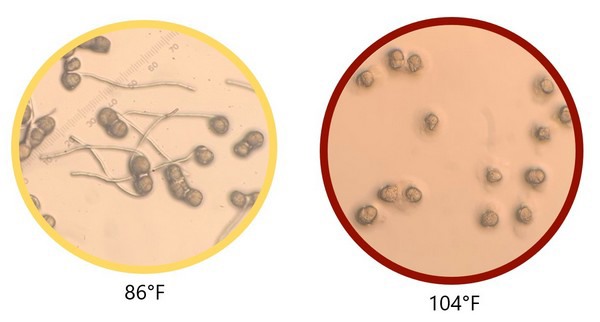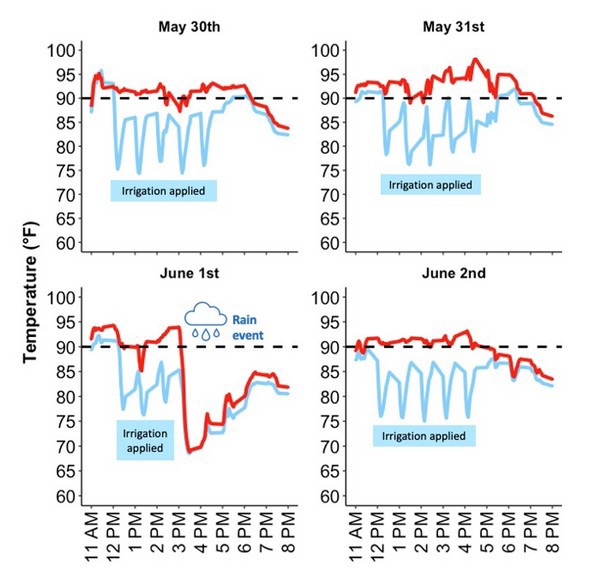The increasing frequency and intensity of high temperature conditions during bloom is a potential risk for blueberry pollination. In some cases, temperatures have exceeded 95 degrees Fahrenheit such as during Memorial Day weekend of 2018. This heat wave was the hottest year on record in the past 92 years, and the Michigan blueberry harvest was 30-50% lower than the previous prior, despite a "snowball" bloom. While the low yield could have been caused by other factors, we have investigated whether the hot conditions might limit blueberry pollen development.
Blueberry pollen was collected from plants grown in the greenhouse and then exposed to a range of temperatures between 50 and 104 F for four hours in an environmental chamber. The pollen was then examined under the microscope for its development after 4 and 24 hours to measure the percent germination and length of pollen tubes.
Pollen development was slow at 50 F as would be expected during cool conditions, and it was optimal at temperatures between 68-86 F. In Figure 1, the yellow circle shows pollen at 86 F with pollen tubes germinated and growing. In red, the 104 F conditions have no pollen tubes. This shows that pollen has been almost completely inhibited from germination by 4 hours of extreme heat exposure.
 Figure 1. Pollen tube growth from blueberry pollen exposed for 4 hours to 86 F (left) or 104 F (right) conditions, showing inhibition of pollen development.
Figure 1. Pollen tube growth from blueberry pollen exposed for 4 hours to 86 F (left) or 104 F (right) conditions, showing inhibition of pollen development.
Between 86 and 104 F, we found that pollen performance steadily declined as temperatures increased, with substantial declines in pollen tube length at temperatures above 90 F (Figure 2). In a separate experiment, we also found that pollen exposed to extreme heat did not rebound and recover, so the effect is permanent.
 Figure 2. Pollen tube length (millimeters) at 4 and 24 hours for Bluecrop, Elliott, Jersey and Liberty cultivars at temperatures between 86–104 F.
Figure 2. Pollen tube length (millimeters) at 4 and 24 hours for Bluecrop, Elliott, Jersey and Liberty cultivars at temperatures between 86–104 F.
From these results, we have developed a warning model to integrate predicted bloom timings and predicted upcoming hot weather, posted for the first time this season on the Michigan State University Enviroweather website: Blueberry Bloom Estimates Model. This provides a color-coded warning for conditions when bloom is predicted to be underway and we have predicted high temperatures above 90 F.
It is also worth noting that air temperatures over weed barrier fabric on sunny days can be 5 degrees hotter than fields with a weed free strip, so those fields should be monitored more closely for temperature during heatwaves. A thermal temperature gun can be used to easily check field conditions.
If predicted field temperatures exceed 90 F, Michigan State University Extension recommends cooling fields if you have solid set overhead irrigation. These systems are typically used for frost protection and irrigation, and they can also prevent blooming fields from reaching the extreme temperatures that inhibit pollen growth. To test the effectiveness of this approach, we ran overhead irrigation in the blueberry planting at the Trevor Nichols Research Center in Fennville, Michigan, during bloom on May 30 – June 2, 2023, with water applied for 15 minutes every hour (for 5 hours) once the air temperatures were expected to exceed 90 F. Figure 3 shows that the irrigation system dropped the air temperature by 10 F, with the evaporative cooling keeping air temperatures below the heat threshold where pollen damage will occur.
During the spring, the water temperature is also lower in ponds and likely assists with reducing the temperature in fields. It is also important to mention that we have seen some evidence of damage to pollen from high temperatures during early flower development, so we recommend overhead irrigation during extreme heat even if the plants are not yet in full bloom.
 Figure 3. Average air temperature (F) in a Bluecrop planting that received overhead irrigation (blue) and no irrigation (red) on May 30 – June 2, 2023. The applications were made every hour for 15 minutes. Dashed, black horizontal lines on figures represent the critical temperature for blueberry pollen injury.
Figure 3. Average air temperature (F) in a Bluecrop planting that received overhead irrigation (blue) and no irrigation (red) on May 30 – June 2, 2023. The applications were made every hour for 15 minutes. Dashed, black horizontal lines on figures represent the critical temperature for blueberry pollen injury.
Current research is exploring potential downsides of in-bloom irrigation including greater risk of disease, and inhibiting bee activity. However, the potential benefits of saving the fruit set and berry size are expected to outweigh these concerns. Reduced bee foraging is also during a small part of the pollination window and is likely to have negligible effect given that bees can still pollinate before and after the irrigation in the same day.
Source: canr.msu.edu
